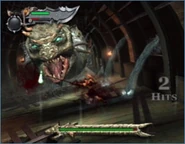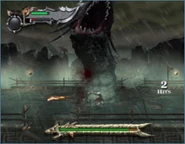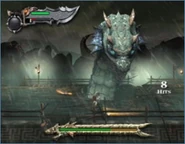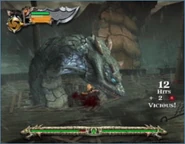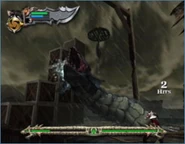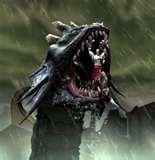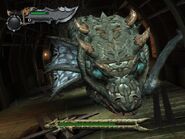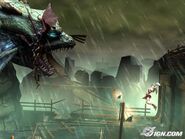| “ | Kratos, before you reach Athens, there is a task you must complete. This beast, this Hydra, it has terrorized my seas for far too long. | ” |
–Poseidon. | ||
The Hydra was a multi-headed sea monster that terrorized the Aegean Sea and was the first boss in God of War
Quick Answers

What is the Hydra's unique ability in Greek mythology?

How many heads does the Hydra typically have in Greek mythology?

What is the Hydra's role in the game God of War?

What are some strategies for defeating the Hydra in God of War?

How does the Hydra's poison affect those around it in Greek mythology?

Greek Mythology
In Greek mythology, the Hydra was a multi-headed serpent monster that lived in a swamp beyond the city of Lerna. It is usually depicted with nine heads, but some stories gave it as few as five, or as many as one hundred. In all of the stories, it was extremely poisonous (many accounts claim that the very air around it could kill a man in seconds), and had the ability to regrow its heads when severed. Some stories elaborated that the Hydra grew two heads for every head that was lost, and that one of its heads (thought to be its "original" and/or largest head) was immortal.
The Hydra was killed by Hercules (or Heracles in Greek) as his second Labor. Holding his breath to avoid breathing in the beast's toxins, he cut off its heads and burned the necks with a torch (provided by his charioteer Iolaus in most stories) to prevent them from regenerating.
Following its death, the Hydra was placed in the stars as a constellation. Hercules was also said to have dipped his arrows in its poisonous blood, giving them unmatched lethality. The Hydra was one of the mightiest and terrible children of Typhon, the Father of Monsters.
In the God of War series
Facing Hercules
In one of his labours, Hercules the son of Zeus strangled and killed the giant beast.
God of War
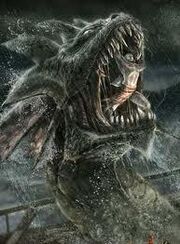
It is unclear whether this Hydra is newly born or infact the same, resurrected one that the mighty Hercules has bested during his legendary labours. Ares implied that his sister Athena has resurrected it to pit him against Poseidon, while the Goddess of Wisdom herself claimed the Hydra to be a freshly born one, concieved by Typhon and Echidna and in the service of Ares.
Zeus noticed it to be larger than the one that his son faught in the past.
In God of War, the Hydra is a massive multi-headed sea serpent roughly the size of a small island. The Hydra King is the dominant, central head that controls the smaller serpent heads around it - if it falls, the entire beast dies with it.
As the game's main narrative begins, Kratos has been assigned by Poseidon, God of the Sea, to kill the beast, which has been challenging his sovereignty by destroying ships and killing sailors. It can be seen attacking Kratos' Fleet as they approach Athens.
Kratos first battles one of the Hydra's lesser heads when it smashes through the side of his ship below the deck. Kratos manages to severely wound it by stabbing its eye and smashing it around with his blades. Another head is seen above deck, attacking another ship alongside a flock of Harpies. After devouring or completely eating a few sailors, it smashes through the ship and starts attacking Kratos, who slays it in turn.
Kratos' final encounter with the Hydra occurs on another ship's deck, where he battles the Hydra King and two of its lesser heads. He finally kills the beast by driving the ship's mast through its main head. The death of the Hydra and its various injuries by Kratos cause a massive ecological disaster, as thausends of sharks alone die from trying to consume its carcass and its poisonous dark blood contaminates the water.
The incident with the Hydra causes a temporary rift between Ares and Poseidon, with great benefit for Kratos as the Lord of the Oceans grants him a sliver of his rage, a powerful divine gift that served him well throughout Athens, the Temple of Pandora and against the God of War himself.
God of War II
The Hydra does not make an actual appearance, but the unlockable Hydra Armor costume appears to have been made from the carcass of the one killed in the first game.
God of War III
The Hydra appears in a flashback after Kratos is betrayed by Gaia and after he awakened Hope from within him. In both sequences Kratos beheads the Hydra King and the two other Hydra heads with the Blades of Chaos.
Hydra Skin
After Kratos became the God of War, and entered the temple on Olympus, he found it decorated with statues of his past enemies. Pandora's Guardian, Ares, and even the Hydra's skin, which was hung behind the throne. Cut off from the lower part of its neck, it displayed the long, serpentine neck, as well as the head, sitting high above the throne. Later, in God of War II, one of the costumes, the Hydra Armor, carries the description: "I always wondered what they did with the body."
Trivia
- As revealed in the novel, the original Hydra was killed by Hercules when Kratos was still a child. The Hydra Kratos faces is a new one born from Typhon and Echidna, according to Athena. This proves the theory that more Hydras exist in Kratos' world of ancient Greece.
- However, the God of War novel stated Hercules had originally killed the Hydra, but it was later resurrected by Athena to trick Poseidon into empowering Kratos.
- The power of the Hydra King was described to be titanic in the novel, which is a reference to its blood relation to the Titans, being a child of Typhon. Kratos with just the Blades of Chaos was ultimately outmatched by the might of the master head and would have died without the power of the oceans, the Rage of Poseidon.
- It is interesting to note that after being questioned by Poseidon for sending the Hydra, Ares states that he had no intentions in killing Kratos because his torment amuses the God of War. Ares would eliminate Kratos himself, rather than sending someone else to do this job. He suggests that it was in fact Athena who sent the Hydra in a clever attempt to trick Poseidon into giving Poseidon's Rage to Kratos. It is also possible that the Hydra was in the Aegean sea at the same time as Kratos by chance.
- Ares made good on that promise in God of War, as when Kratos retrieves Pandora's Box, Ares impaled him to the wall with a giant pillar.
- Zeus was surprised to see the Hydra when Athena showed it to him, as it was killed by Hercules a long time ago.
- Poseidon explains to Kratos in the novelization that the lesser heads are "without number" and the Hydra barely notices their loss.
- Oddly, after defeating the Hydra King, if Kratos backtracks, a lesser head is still seen attacking a group of sailors in the background. This was highly likely caused by a developer error.
- The Hydra, along with the Hydra King, appear as a stage hazard in PlayStation All-Stars Battle Royale in the stage of Metropolis, along with Captain Qwark, both from the Ratchet and Clank series.
- In the Bibliotheca, the immortal head of the Hydra was disposed of by Hercules by pinning it under a massive rock.
- The Hydra is mentioned in God of War (2018), in one of the treasure maps. The map's creator talks of a key, and how the "boat captain" lies in the creature's belly, suggesting that the map is quite old, as well as perhaps Greek in origin. The map appears to be referencing the captain from God of War.
- In God of War: Ragnarok, Mimir refers to the Hydra as a "three-headed sea serpent", despite it having had at least five heads, and several more seen in the background that are not fought by the player.
- The official God of War II artbook states that the Hydra was born from Typhon, much like the myths portray.
Gallery
Video
thumb|200px|left

